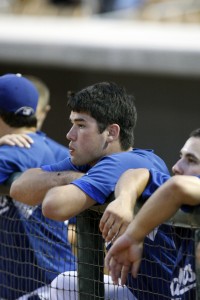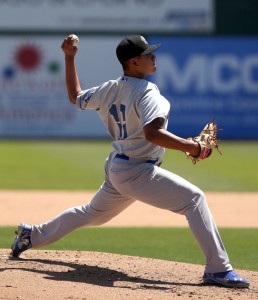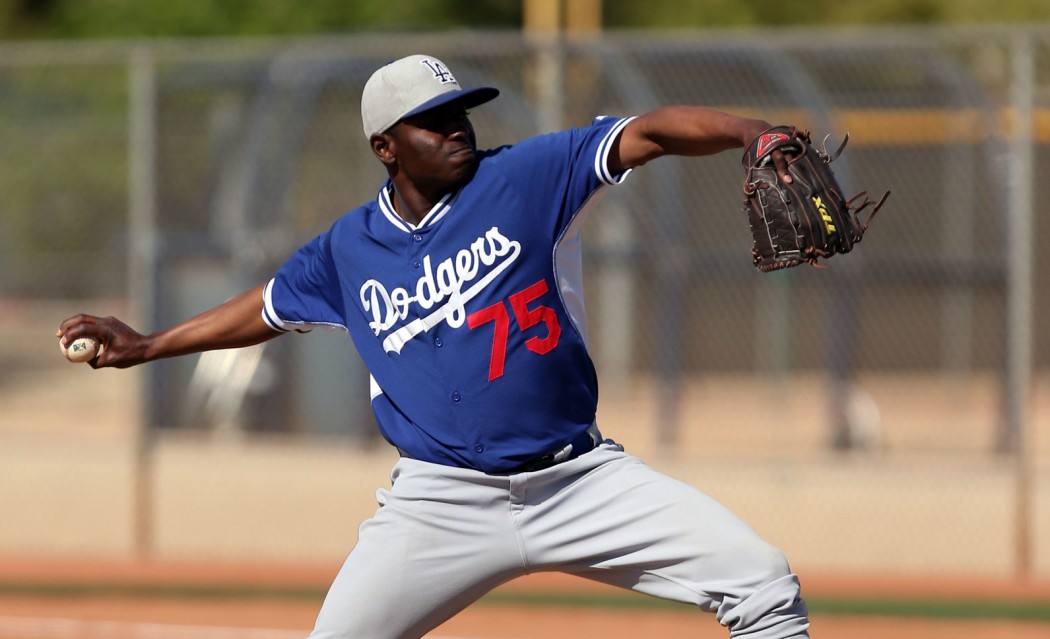Feature Photo: Jharel Cotton, RHP, Dodgers
(Editor’s Note) Today we’re excited to welcome Jared Massey as a new contributor to 2080 Baseball. Jared covered the Los Angeles Dodgers and their farm system for LADodgerTalk.com, Scout.com, and DodgersNation.com from 2010-2015. He currently writes for DodgerBlue.com, and co-hosts the podcast “Dugout Blues”.
 A wise man once said, “You can never have too much pitching.” This was prescient for the 2015 Los Angeles Dodgers, who lost two-fifths of their projected big league starting rotation, (Hyun-jin Ryu and Brandon McCarthy), last year before the end of April to the disabled list. With their Oklahoma City Triple-A affiliate consisting mostly of retreads and fringe-level major leaguers, Los Angeles supplemented their depleted rotation with the likes of Carlos Frias, Scott Baker, Brandon Beachy, and Joe Wieland. For the season, they relied on no fewer than 16 pitchers to start at least one game last season. Despite so many spot-starters flowing through the roster, the Dodgers still managed to finish fifth in the major leagues with a 3.44 team ERA.
A wise man once said, “You can never have too much pitching.” This was prescient for the 2015 Los Angeles Dodgers, who lost two-fifths of their projected big league starting rotation, (Hyun-jin Ryu and Brandon McCarthy), last year before the end of April to the disabled list. With their Oklahoma City Triple-A affiliate consisting mostly of retreads and fringe-level major leaguers, Los Angeles supplemented their depleted rotation with the likes of Carlos Frias, Scott Baker, Brandon Beachy, and Joe Wieland. For the season, they relied on no fewer than 16 pitchers to start at least one game last season. Despite so many spot-starters flowing through the roster, the Dodgers still managed to finish fifth in the major leagues with a 3.44 team ERA.
Heading into the 2016 season, the Dodgers’ rotation is now a crowded group, boasting returning starters Clayton Kershaw, Brett Anderson, and Alex Wood, as well as free agent acquisitions Scott Kazmir and Kenta Maeda. Also in the mix is Hyun-jin Ryu, who missed the entire 2015 season with a shoulder injury. That’s six potential starters for five spots.
While the Dodgers’ off-season moves certainly addressed its rotation issues, the stockpile of starters creates another issue for the team. Unlike last year, the Dodgers’ rotation at Triple-A Oklahoma City won’t be filled with veterans to be plucked for spot starts. Instead, it should now be home to some of the Dodgers’ best pitching prospects, such as Julio Urias, Jose De Leon, Frankie Montas, Jharel Cotton and Chris Anderson. The Dodgers will be faced with a challenging balance between developing these young arms and making room for them on the major league roster. While it can be assumed that the more experienced pitchers will get first crack at a spot start, Dodgers President of Baseball Operations Andrew Friedman and his front office team may have some spirited discussions regarding which prospects get the call if an injury creates a prolonged opening in the rotation.
The first two names that come to mind are Urias and De Leon. Both are non-roster invitees to spring training this year, giving the powers that be an up-close audition for the coming season. Urias was recently ranked as the top left-handed pitcher in the minor leagues by MLB.com, while De Leon clocked in at number five on MLB.com’s right-handed list. Urias is still a teenager, having turned 19 in August, while De Leon turned 23 that same month. Both pitched primarily at Double-A Tulsa last season, while Urias made a pair of appearances with Triple-A Oklahoma City at the end of the year.
In terms of practicality, a prospect’s presence on the 40-man roster could also play a major part in deciding whether he plays in the big leagues next season. This filter brings up Frankie Montas and Jharel Cotton. Montas, acquired in December in the Dodgers’ three-team trade with the Reds and White Sox, made his major league debut last season with Chicago. The 22-year-old right-hander posted an ERA of 4.80 in 15 IP. Cotton, originally selected in the 20th round of the 2012 MLB First-Year Player Draft, reached Triple-A Oklahoma City last season and was considered for a September call-up.

Zach Lee, RHP, Dodgers
Two former Dodgers first-round picks are seemingly on the outside looking in. Zach Lee, drafted 28th overall in 2010 – and once thought of as the organization’s best prospect – made his major league debut last year on July 25 against the Mets and struggled mightily, allowing seven runs in 4 2/3 IP. Chris Anderson, picked 18th overall by the Dodgers in 2013, received a late-season promotion to Triple-A Oklahoma City, and also dealt with adversity, surrendering 15 runs in 6 1/3 IP. While Lee sported a 2.70 ERA in 19 starts covering 113 1/3 IP at Oklahoma City, Anderson posted a 4.74 mark over 133 IP that were split between Double-A and Triple-A.
With six pitchers already fighting for spots in the big league rotation, and half a dozen more nearly major league-ready, Friedman and the front office could decide the best use of their resources is to turn quantity into quality. The Dodgers do not have any glaring roster needs at the moment, but they could still seek to strengthen their bullpen in the free agent market, or through a trade. Their pursuit of Cincinnati Reds closer Aroldis Chapman, was derailed, (the Reds flamethrower was ultimately dealt to the New York Yankees), so they responded by signing fee agent right-hander Joe Blanton to a one-year deal. Still, acquiring a top-shelf relief arm remains a possibility.
It would be hard to pry Urias or De Leon from the Dodgers’ clutches, likely requiring the return of a star player to advance talks from the Dodgers on dealing one of their two best pitching prospects. Montas and Cotton could spark interest from other clubs, though the return would not be as great. They would need to be packaged with a major leaguer or other prospects to net a valuable player. Anderson and Lee would merely be throw-ins at this point. Hopefully they can recoup some of their trade value with solid performances in 2016.
Perhaps the best course of action will be to simply let the players continue developing within the Dodgers’ farm system. None of these pitchers are out of options or demanding a trade. If an opportunity comes up to improve the major league team and the front office deems a trade a net-positive, then they should pull the trigger. Otherwise, they can let the prospects continue to do their work on the farm and inch ever closer to their major league dreams.
So, who would get the first crack at an open rotation spot in the coming season, if-and-when injuries arise? The smart money is on someone who’s already on the 40-man roster and has some major league experience. Frankie Montas fits the bill, even if he’s not the most major league-ready. To step into the big league rotation early in the season, he’ll have to show the Dodgers he has improved his control issues seen last year. But, with a bullpen that already projects to be used early and often in 2016, Montas might be a fit.
What about Jharel Cotton? He’s on the 40-man roster and throws strikes. Sure, he barely pitched above Double-A last year, but the Dodgers still considered bringing him up despite the perception that he lacked enough experience. His long-term role, be it as a starter or in relief, has been questioned. Former 2080 Contributor Tucker Blair said of him last year in his 2080 Scouting Report, “I think Cotton will be fine in a starter role,” but added, “he isn’t going to be a workhorse.” However, like Montas, Cotton could also be used to boost or supplement a bullpen that projects to be used with great frequency.

Julio Urias, LHP, Dodgers
Of course, the club could opt to simply “go big” and bring up a top prospect. While fans may clamor for Urias, he’s simply not ready yet. After pitching just over 80 innings last season, he needs a controlled environment to continue to refine his skills, such as improving his command and becoming more efficient with his pitch counts. As much as fans and the front office would love to see him in the majors in 2016, he needs to be focused on building his arm strength over a full season of work – focusing more on upping his innings count while delivering consistent, quality outings over time.
And that leads us to the top option to get time with the Dodgers in 2016: Jose De Leon. He’s old enough, he has the stuff, he can throw strikes, and he pitched enough innings last season to increase his workload without fear of breaking down. Yes, he would require the Dodgers to open a slot on the 40-man roster, but he’s worth replacing an emergency bullpen arm like Josh Ravin or one of the club’s many spot-starters, such as Ian Thomas. Plus, it’ll give fans something to cheer about while they’re watching their old Zack Greinke jerseys collect dust in the closet.
The future is bright for the Dodgers. While 2016 won’t exactly break the mold for the franchise, it will give a glimpse to the team’s horizon, filled with homegrown talent reminiscent of championship teams of the past. Think of this year as the water knocking down the sandcastle before the tidal wave hits.


